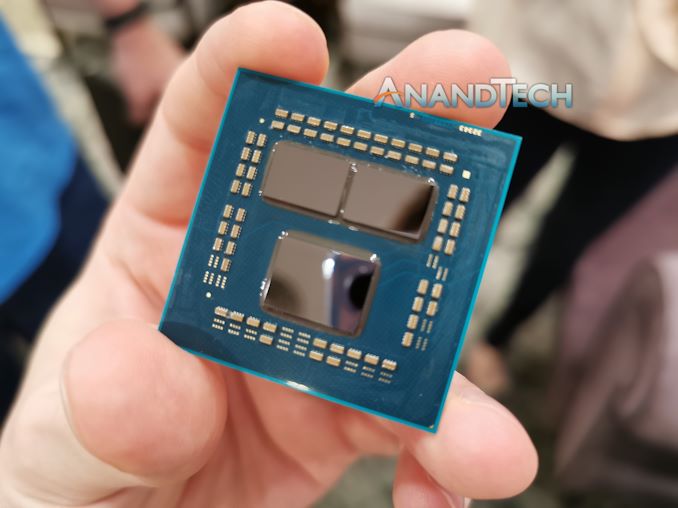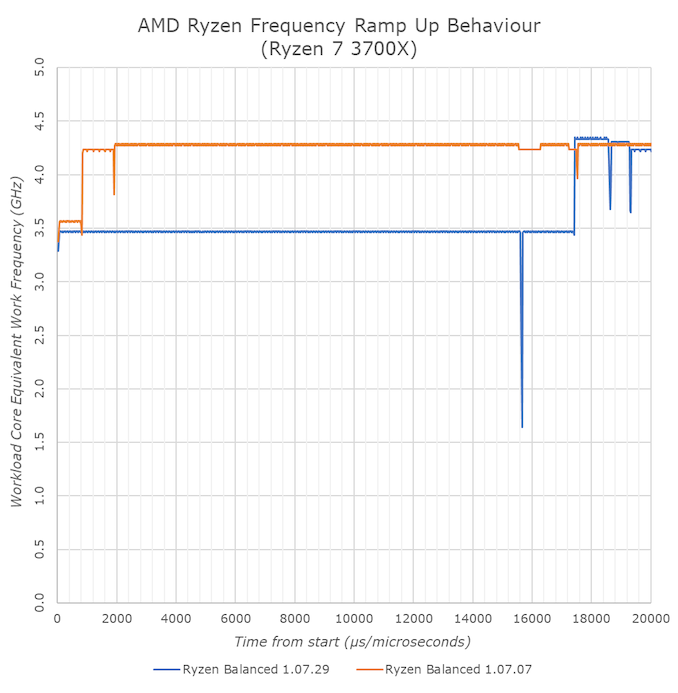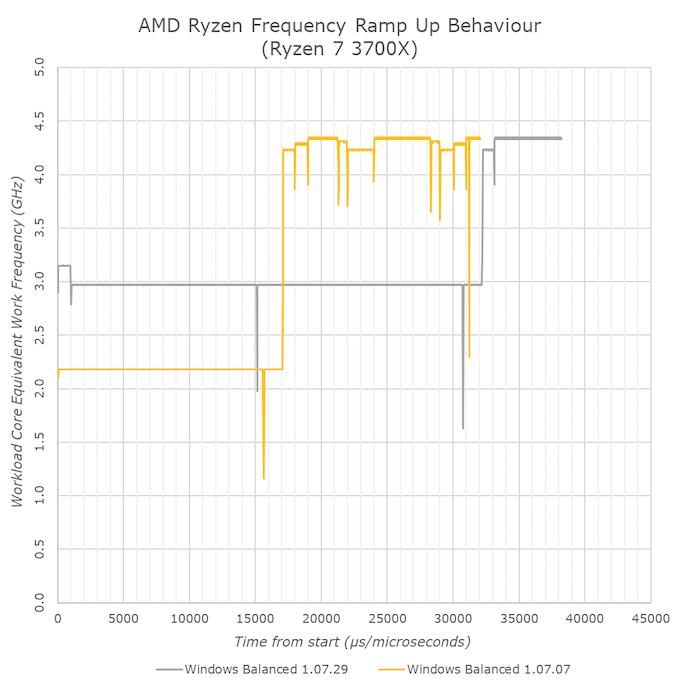AMD Releases New Chipset Drivers For Ryzen 3000: More Relaxed CPPC2 Upscaling
by Andrei Frumusanu on July 30, 2019 5:00 PM EST
It’s been nearly three weeks since AMD’s launch of the new Ryzen 3000 series CPUs and our extensive coverage of the new parts. Among one of the things that didn’t quite go as smoothly is AMD’s BIOS and software situation where as things were still very much in flux following the launch.
One issue that was repeatedly brought up by the community over the past weeks was the new CPU’s idle behaviour both in terms of temperature as well as voltages. In particular, the new parts seemingly looked like they rarely idled at lower performance states and instead looked to remain at high frequencies even when not doing much.
While initially appearing as an issue, it really wasn’t one and rather just a side-effect of AMD’s new CPPC2 fast frequency ramp-up behaviour. Monitoring applications that are badly programmed tend to have a too heavy of a monitoring loop that causes load on the CPU – triggering a frequency ramp-up as the CPU is seeing a larger load. Given the new CPU’s sub-1ms ramp-up this meant that it was very hard to actually catch the machine at the lower frequencies – even though it most likely did idle correctly.
AMD has now addressed this concern and tweaked the CPPC2 behaviour in the new Ryzen power plans with the release of a new chipset driver package.
As AMD states in their community brief on the issue, part of the new behaviour change is that the new scheduler settings will now have a much more relaxed ramp-up time compared to the previous versions. In particular, when the chip will be at its base frequency and idling voltage, it will now take a significantly longer load for the chip to ramp up to its boost frequencies.
In our quick A/B testing between the two driver versions, we can see that prior to the update the CPU would ramp up in around 840 microseconds to its boost clocks, whilst on the new power plan in this data-set took it a longer 17.5 milliseconds.
The new behaviour thus should make the CPU ramp-up much less susceptible to smaller transient loads. The new boost duration is still very much adequate and extremely fast – sustained CPU workloads will see largely imperceptible difference, while intermittent workloads such as games also won’t be affected as once the CPU gets over the initial base frequency ramp threshold it maintains the sub-1ms frequency change behaviour.
Users who with to maintain the fast up-scaling behaviour can choose to use the Performance power plan which largely retains a similar performance profile to that of the previous Balanced profile.
I also took a look at the Windows power plans if they changed, and it seemed that they indeed did. While on the old version the CPU would idle at ~2.2GHz, the new driver idles at 3GHz. Seemingly the frequency up-scaling has also been slightly slowed down as in my quick testing I saw frequency ramp up half as quickly.
AMD has also addressed concerns about the reported high temperatures of the chip. The company explains that generally the value that most applications are reading out is the maximum of several sensors on the chip. Essentially this acts as the junction temperature of the chip – whilst most of the die would actually be a different/lower temperature.
A new version of Ryzen Master now includes a different temperature readout algorithm that is meant to better represent the “overall” temperature of the die rather than the absolute maximum a sensor reports. AMD says this is a better representation of the temperature of the CPU. Besides averaging across different sensors, it also averages readouts over a small time-window. In my testing the most affected scenarios are idle and low-load scenarios and the new temperature behaviour isn’t nearly as erratic and spiky.
Note: People have reported performance degradations with the new driver. These degradations have nothing to do with the new power plan / idle behaviour; it's more likely that this is caused by the temporary workaround for the RDRAND (Destiny 2) issues. One can maintain the original performance with the new Balanced power plan idle behaviour by simply selectively installing the new 5.0.0.0 power plan on top of the 07.07 chipset driver release.
Related Reading:
Source: AMD Community Update














39 Comments
View All Comments
Gothmoth - Tuesday, July 30, 2019 - link
well i don´t see this new "released" driver at amd´s website...Andrei Frumusanu - Tuesday, July 30, 2019 - link
In the link of the source.Dark42 - Tuesday, July 30, 2019 - link
The 2nd graph (and text) shows the new version to idle at 3,0 GHz instead of ~2,2 GHz and taking longer to reach max frequencies.Am I missing something or is that just a step backwards?
Higher idle frequency means more power draw during idle and slower reaction to load doesn't sound better either.
This sounds somewhat like they try to fix the reported values when in reality the CPU works fine, just the software isn't up to date.
And instead of changing the software, now they change the CPU behavior making it somewhat worse but look better?
I'd like to at least have some options to adjust this behavior.
Scabies - Tuesday, July 30, 2019 - link
"If a processor core is truly running no workload, the processor core will be placed into the “CoreC6” (CC6) power-gated sleep state. Presently, AMD Ryzen Master is the only tool that can show
this CC6 state (Figure 3 attached). This state may be opportunistically engaged hundreds of times
per second. Voltages in this condition might be as low as 0.200V, and clockspeeds down to
0MHz/Sleep are also possible.
deil - Wednesday, July 31, 2019 - link
They went back to tackle some issue, (propably one that stops linux from using the CPU) I Think they know how to make this better, it just need some more time.ReeZun - Tuesday, July 30, 2019 - link
[a] I noticed that you only posted results for 'Windows Balanced'. With the new chipset drivers, is the response time also affected for 'AMD Ryzen High Performance' (and other power plans)?What if one prefers the 'former' behavior (of sub 1-ms response times)? Is there a way to adjust the settings (with the new chipset drivers) and/or will AMD keep an archive of different chipset driver releases (to suit the requirements of different users)?
hansmuff - Tuesday, July 30, 2019 - link
I would like answers to this as well. I very much LIKE the way this CPU behaved before this change. I WANT ultra fast ramp up so I get ultra fast responsiveness. I don't give a crap about 40C IDLE or really any of the complaints.Please AMD, if this has to be like that, please do publish an alternative for the old path.
The_Assimilator - Wednesday, July 31, 2019 - link
You're either a moron, illiterate, or a robot if you believe you can feel the difference between 840µs and 17.5ms.ImSpartacus - Wednesday, July 31, 2019 - link
The user probably can't, but their battery might."Race To Sleep" is a thing and I hope AMD doesn't hold back when they implement this stuff in mobile because it will result in battery life savings.
jaju123 - Wednesday, July 31, 2019 - link
I dont think race to sleep is affected as it will still change clocks/voltage in under 1ms in response to load alterations once the initial ramp is completed.